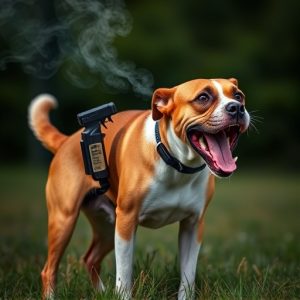Dog Repellent Spray Range: Maximize Effectiveness with Training Tips
Dog repellent spray is a versatile tool for canine training, leveraging natural aversion responses t…….
Dog repellent spray is a versatile tool for canine training, leveraging natural aversion responses to teach dogs about personal space and boundaries. Its effectiveness depends on environmental conditions, spray type, and strategic training exercises with clear commands like "leave it" or "back away". Safe usage requires proper ventilation, protective gear, and gradual distance increase during regular, short sessions to enhance comfort zones and prevent reactive behaviors.
Discover the power of dog deterrent spray—a safe, effective tool for training and controlling canine behavior. This comprehensive guide explores how these sprays work, delving into factors that influence their range and offering practical tips for integration into your dog’s exercise routine. Learn about safety precautions to ensure successful, responsible use of dog repellent spray training exercises, enhancing both control and your bond with your pet.
- Understanding Dog Deterrent Spray: What It Is and How It Works
- Factors Affecting the Effective Range of Dog Repellent Spray
- Integrating Spray Training into Your Dog's Exercise Routine
- Safety Precautions and Tips for Using Dog Deterrent Spray Effectively
Understanding Dog Deterrent Spray: What It Is and How It Works
Dog deterrent spray, also known as dog repellent spray, is a popular tool for training and managing canine behavior. It’s not just about scaring dogs; rather, it’s a carefully formulated solution designed to trigger a natural aversion response in dogs when they come into contact with the spray. This repellency helps teach them to associate certain areas or behaviors with an unpleasant sensation, thereby encouraging desired actions during training exercises.
The effectiveness of dog repellent spray lies in its ability to create a defined space where dogs are less likely to enter or engage in unwanted behavior. When used during training, it can help establish boundaries and reinforce positive commands. Dog owners often incorporate these sprays into their training routines, focusing on specific behaviors like jumping, barking, or biting. The key is consistent application and timing; the spray should be used immediately upon displaying the unwanted behavior to create a lasting association in the dog’s mind.
Factors Affecting the Effective Range of Dog Repellent Spray
The effective range of a dog deterrent spray can be influenced by several factors, which are essential to understand for optimal usage. One key consideration is the environmental condition; weather and terrain play a significant role. For instance, wind direction and strength can impact how far the spray reaches, with headwinds potentially reducing its effectiveness as it blows away from the target area. Additionally, factors like humidity and temperature affect the spray’s evaporation rate, influencing its duration and range.
Another critical aspect is the type of dog repellent spray used. Different formulations have varying concentrations and active ingredients, which directly impact their performance. Some sprays may require closer application for immediate deterrence, while others can provide a longer-lasting protection zone. Training exercises using these products also come into play; proper technique and timing during training sessions can enhance the spray’s effective range, ensuring it reaches the desired distance to discourage unwanted canine behavior effectively.
Integrating Spray Training into Your Dog's Exercise Routine
Integrating spray training into your dog’s exercise routine is a highly effective way to teach them about personal space and boundaries, using their natural curiosity as a learning tool. Start by selecting a dog repellent spray specifically designed for training purposes, ensuring it has a controlled release mechanism for safety. During walks or playtime, introduce the spray in a controlled environment, spraying towards objects your dog approaches or tries to touch. The sudden burst of scent should capture their attention and encourage them to pause and think before reacting again.
As you spray, issue clear commands like “leave it” or “back away.” Reward calm behavior with treats and praise, while maintaining the spray’s effective range. Consistency is key; regular sessions, even for short periods, will reinforce the training. Gradually increase the distance between you and your dog during these exercises to expand their comfort zone and enhance their understanding of personal space.
Safety Precautions and Tips for Using Dog Deterrent Spray Effectively
When using dog deterrent spray, safety should always be a top priority. It’s crucial to ensure that both you and your canine companion are protected during application. Always consult with a veterinarian or professional dog trainer before introducing any new deterrent method, especially if your dog has sensory sensitivities or health conditions. Wear protective gear like gloves and eye goggles to avoid direct contact with the spray. Additionally, make sure to apply the spray in well-ventilated areas to prevent inhalation of chemicals by both you and your pet.
To maximize the effectiveness of dog repellent spray, incorporate it into training exercises. Start by teaching your dog basic commands like “leave it” or “back away.” Once they understand these cues, gradually introduce the spray while simultaneously issuing the command. Reward them for responding positively to the command, reinforcing the association between the behavior and the deterrent spray’s presence. Regular practice in controlled environments will help desensitize your dog to potential triggers, making them less likely to react aggressively or fearfully in future encounters.
Dog repellent spray can be an effective tool in training your dog, but understanding its range and proper usage is key. By integrating spray training into exercise routines, you can enhance your dog’s behavior both indoors and outdoors. Remember to consider environmental factors and always prioritize safety when using any deterrent. Incorporating these strategies ensures successful Dog Repellent Spray Training Exercises while fostering a positive learning environment for your canine companion.


